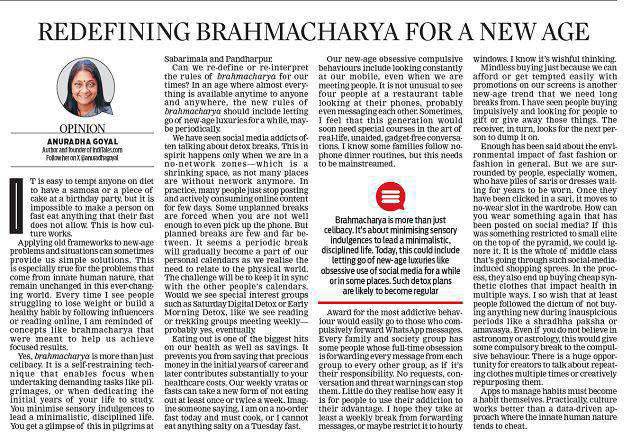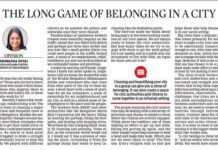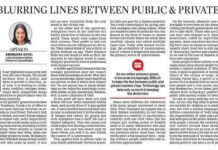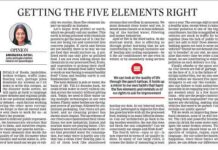It is easy to tempt anyone on diet to have a samosa or a piece of cake at a birthday party, but it is impossible to make a person on fast eat anything that their fast does not allow. This is how culture works.
Applying old frameworks to new-age problems and situations can sometimes provide us simple solutions. This is especially true for the problems that come from innate human nature, that remain unchanged in this ever-changing world. Every time I see people struggling to lose weight or build a healthy habit by following influencers or reading online, I am reminded of concepts like brahmacharya that were meant to help us achieve focused results.
 Yes, brahmacharya is more than just celibacy. It is a self-restraining technique that enables focus when undertaking demanding tasks like pilgrimages, or when dedicating the initial years of your life to study. You minimise sensory indulgences to lead a minimalistic, disciplined life. You get a glimpse of this in pilgrims at Sabarimala and Pandharpur.
Yes, brahmacharya is more than just celibacy. It is a self-restraining technique that enables focus when undertaking demanding tasks like pilgrimages, or when dedicating the initial years of your life to study. You minimise sensory indulgences to lead a minimalistic, disciplined life. You get a glimpse of this in pilgrims at Sabarimala and Pandharpur.
Brahmacharya For The New Age
Can we re-define or re-interpret the rules of brahmacharya for our times? In an age where almost everything is available anytime to anyone and anywhere, the new rules of brahmacharya should include letting go of new-age luxuries for a while, maybe periodically.
We have seen social media addicts often talking about detox breaks. This in spirit happens only when we are in a no-network zones—which is a shrinking space, as not many places are without network anymore. In practice, many people just stop posting and actively consuming online content for few days.
Some unplanned breaks are forced when you are not well enough to even pick up the phone. But planned breaks are few and far between. It seems a periodic break will gradually become a part of our personal calendars as we realise the need to relate to the physical world. The challenge will be to keep it in sync with the other people’s calendars. Would we see special interest groups such as Saturday Digital Detox or Early Morning Detox like we see reading or trekking groups meeting weekly—probably yes, eventually.
Eating out is one of the biggest hits on our health as well as savings. It prevents you from saving that precious money in the initial years of career. Later, contributes substantially to your healthcare costs. Our weekly vratas or fasts can take a new form of not eating out at least once or twice a week. Imagine someone saying, I am on a no-order fast today and must cook, or I cannot eat anything salty on a Tuesday fast.
Handling OCD
Our new-age obsessive compulsive behaviours include looking constantly at our mobile, even when we are meeting people. It is not unusual to see four people at a restaurant table looking at their phones. They are probably even messaging each other. Sometimes, I feel that this generation would soon need special courses in the art of real-life, unaided, gadget-free conversations. I know some families follow no-phone dinner routines, but this needs to be mainstreamed.
Award for the most addictive behaviour would easily go to those who compulsively forward WhatsApp messages. Every family and society group has some people whose full-time obsession is forwarding every message from each group to every other group. As if it’s their moral responsibility. No requests, conversation and threat warnings can stop them. Little do they realise how easy it is for people to use their addiction to their advantage. I hope they take at least a weekly break from forwarding messages, or maybe restrict it to hourly windows. I know it’s wishful thinking.
Mindless buying just because we can afford or get tempted easily with promotions on our screens is another new-age trend that we need long breaks from. I have seen people buying impulsively and looking for people to gift or give away those things. The receiver, in turn, looks for the next person to dump it on.
Fast Fashion Woes
Enough has been said about the environmental impact of fast fashion or fashion in general. But we are surrounded by people, especially women, who have piles of saris or dresses waiting for years to be worn. Once they have been clicked in a sari, it moves to no-wear slot in the wardrobe. How can you wear something again that has been posted on social media? If this was something restricted to small elite on the top of the pyramid, we could ignore it. It is the whole of middle class that’s going through such social-media-induced shopping sprees. In the process, they also end up buying cheap synthetic clothes that impact health in multiple ways.
I so wish that at least people followed the dictum of not buying anything new during inauspicious periods like a shradhha paksha or amavasya. Even if you do not believe in astronomy or astrology, this would give some compulsory break to the compulsive behaviour. There is a huge opportunity for creators to talk about repeating clothes multiple times or creatively repurposing them.
Apps to manage habits must become a habit themselves. Practically, culture like Brahmacharya practices works better than a data-driven approach where the innate human nature tends to cheat.
First Published in The New Indian Express on Jun 02, 2024.








